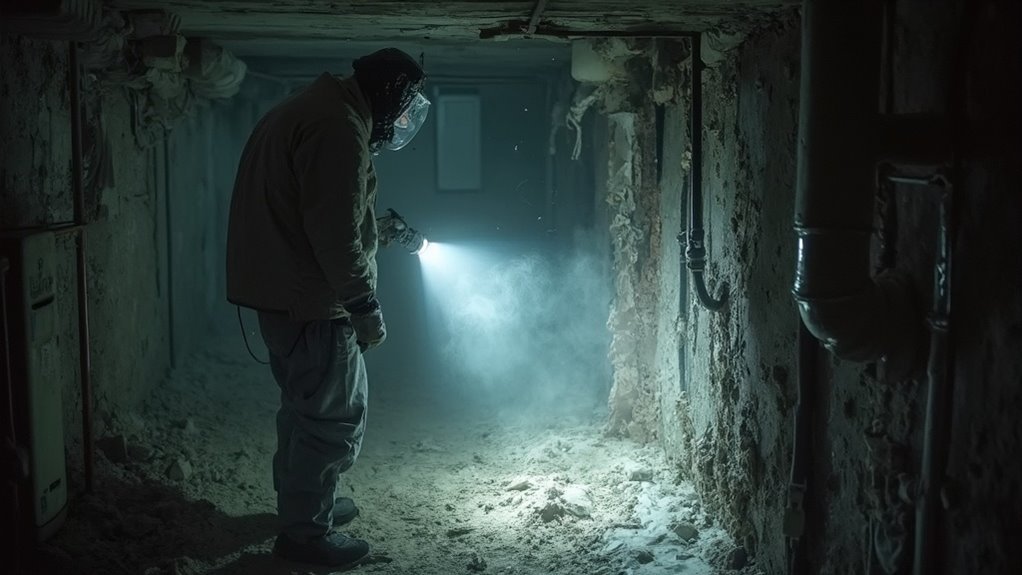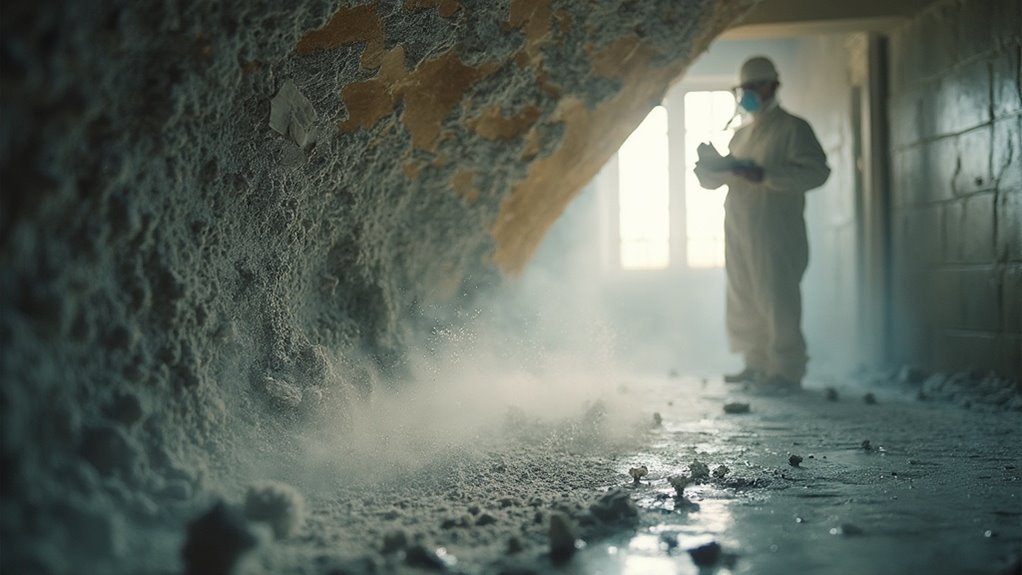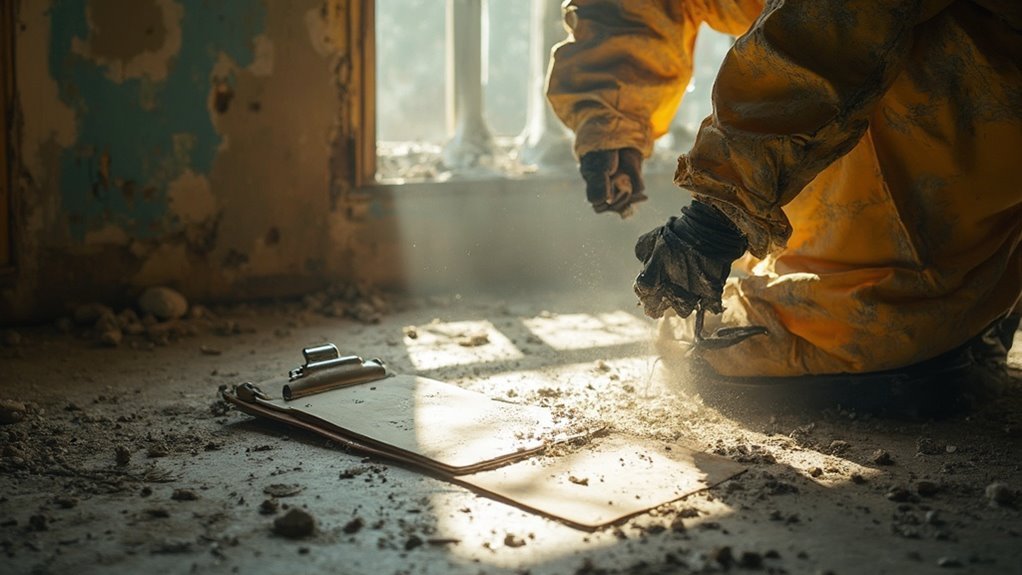An asbestos inspection helps uncover hidden health risks that could impact you, especially if you're unknowingly exposed. Certified inspectors identify materials that may contain asbestos and assess potential exposure routes. Asbestos fibers can linger in the air and lead to serious health issues, including asbestosis and lung cancer, which often develop years later. By conducting a thorough inspection, you can manage these risks and guarantee compliance with regulations. Understanding the inspection process and its implications is vital for your safety. Learning how to address any detected asbestos can substantially reduce health hazards associated with this dangerous material.
Understanding Asbestos and Its Risks

Asbestos, a naturally occurring group of minerals, poses significant health risks due to its fibrous composition. There are six recognized asbestos types, each capable of causing serious health issues. All forms of asbestos are classified as cancer-causing agents, with no safe level of exposure. The primary danger lies in the fibrous structure of asbestos; when disturbed, it breaks down into microscopically thin fibers that can become airborne and easily inhaled. All asbestos fibers are harmful if breathed, regardless of the amount or duration of exposure.
Approximately 30 million homes and buildings in the U.S. may contain asbestos-containing materials, often utilized in construction because of their heat-resistant properties. However, the fiber dangers associated with these materials cannot be overstated. Long-term exposure to asbestos can lead to debilitating diseases such as asbestosis, lung cancer, and mesothelioma, often surfacing decades after initial exposure.
Additionally, the risk of developing these conditions is heightened for individuals who smoke, particularly those who have encountered asbestos as well. Understanding these risks is vital for anyone living or working in environments where asbestos may be present. Being aware of the types and dangers can empower you to take preventive measures and seek professional inspections when necessary.
Importance of Asbestos Inspections
When planning any renovation or demolition project, understanding the importance of asbestos inspections is essential to guarantee safety and compliance. These inspections are not just a formality; they play a critical role in regulatory compliance, confirming you meet federal, state, and local regulations. Without an asbestos survey, you may face permitting requirements that delay your project or lead to unexpected liabilities.
Consider these key points:
- Due Diligence: Performing an asbestos inspection is part of your legal responsibility, particularly in the construction industry.
- Risk Management: Identifying asbestos-containing materials helps you manage risks effectively, preventing costly delays and health hazards.
- Commercial Transactions: Buyers and sellers often request asbestos surveys as part of real estate transactions to confirm transparency.
Health Risks From Undetected Asbestos

Undetected asbestos poses significant health risks that can have long-lasting effects on individuals exposed to its fibers. You may be unknowingly inhaling asbestos fibers that linger in the air, especially in older buildings where asbestos-containing materials were commonly used. This exposure can occur not only in dusty environments but through contaminated clothing as well, affecting even those who live with asbestos workers.
Asbestos testing is critical for identifying these hidden dangers. The inhalation of asbestos fibers can lead to serious conditions, including asbestosis, lung cancer, and mesothelioma. Symptoms often appear years after exposure, making early detection essential. Common indicators such as persistent cough, shortness of breath, and chest pain can signal underlying issues related to asbestos exposure.
Furthermore, benign conditions like pleural plaques can develop without immediate symptoms, yet they indicate prior exposure. By understanding the fiber inhalation risks associated with undetected asbestos, you can take proactive measures to protect yourself and your loved ones. Regular screenings and informing healthcare providers about any potential exposure history are key steps toward mitigating these health risks.
The Inspection Process Explained
The inspection process for asbestos is a critical step in safeguarding health and ensuring compliance with safety regulations. When you initiate an inspection, it's essential to follow established inspection protocols. A certified asbestos inspector will conduct a thorough visual inspection of your premises, identifying suspect materials that may contain asbestos.
Key components of the inspection process include:
- Documenting the presence of asbestos-containing materials (ACMs)
- Utilizing effective sampling techniques to collect samples safely
- Analyzing samples in a specialized laboratory to determine asbestos type and concentration
Following the visual assessment, the inspector will decide whether sampling is necessary. If so, samples are collected without causing unnecessary exposure or disturbance. These samples are then analyzed using methodologies like Polarized Light Microscopy (PLM) or Transmission Electron Microscopy (TEM) to identify the presence of asbestos fibers.
The results guide the planning of appropriate remediation measures, ensuring that you can take informed actions to mitigate risks. By adhering to federal and state regulations, you not only protect your health but comply with legal requirements as well.
Taking Action After Inspection Findings

Having completed the asbestos inspection, it's essential to act swiftly on the findings to mitigate health risks and guarantee compliance. If the report indicates the presence of asbestos, begin by obtaining a detailed asbestos abatement plan. Engage licensed asbestos removal contractors who are well-versed in abatement protocols. Verify that work areas are sealed with plastic sheeting and negative air pressure to prevent the spread of fibers.
During the removal process, specialized tools and wet methods should be used to minimize dust generation, followed by thorough cleaning with HEPA vacuums. Upon completion of the removal or encapsulation, conduct post removal verification to confirm the property is safe. This includes air quality testing to verify asbestos levels fall below acceptable limits.
It's critical to follow regulatory guidelines for asbestos disposal, verifying that all waste is disposed of in licensed landfills. Document all procedures and results for future reference and compliance. Consider scheduling follow-up inspections to maintain safety and verify the property remains free from asbestos risks. By taking these steps, you not only protect your health but additionally adhere to legal requirements.
Frequently Asked Questions
How Much Does an Asbestos Inspection Typically Cost?
Asbestos inspection fees typically range from $225 to $2,000, with average costs around $483. Lab costs may increase your total, especially if further testing is necessary, highlighting the importance of thorough inspections for safety.
How Often Should I Have an Asbestos Inspection?
You should schedule asbestos inspections based on building age and material condition. Older structures or those with damaged asbestos-containing materials require more frequent checks to guarantee safety and compliance with regulations. Regular monitoring is crucial.
Can I Perform an Asbestos Inspection Myself?
You can't effectively perform an asbestos inspection yourself because of DIY risks. Professional sampling guarantees accurate identification and minimizes health hazards, while untrained handling may release harmful fibers, endangering your safety and others.
What Should I Do if I Find Asbestos?
If you find asbestos, don't disturb it. Seal the area and contact a professional for asbestos mitigation. They'll conduct safe assessment and abatement, ensuring proper handling and minimizing health risks associated with asbestos exposure.
Are There Any Home Remedies for Asbestos Removal?
Home remedies for asbestos removal aren't recommended. Instead, consider wetting methods and proper containment measures to minimize fiber release. Professional assistance guarantees safe handling, compliance with regulations, and effective removal without risking your health.
